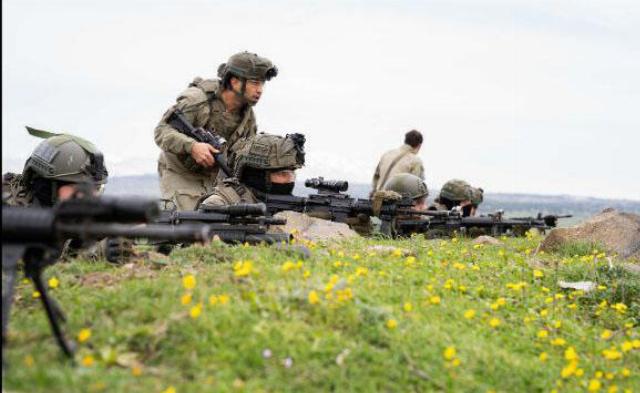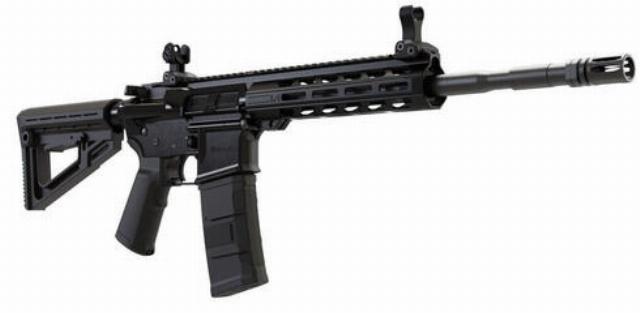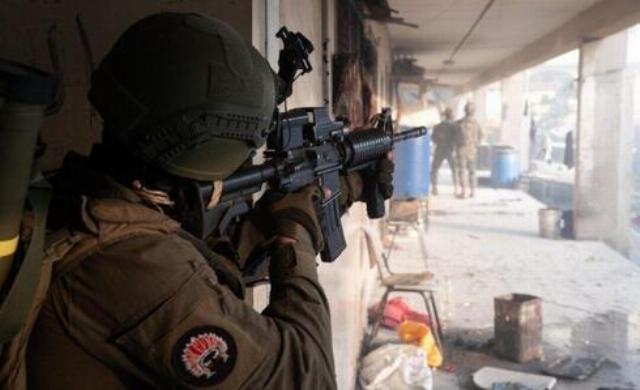The original was taken from a colleague of olegranovsky in the Infantry of the AOI returns to the "Arches"
The main armament of the infantry over the past almost 140 years has been rifles with a unitary cartridge with smokeless powder (the first was the French Lebel model 1886 M93). From magazine rifles they switched to self-loading and automatic (including later weapons chambered for 7.62×51mm NATO, from 1954), then to assault rifles (submachine guns) with an intermediate cartridge (German 7.92×33mm Kurz in 1942, Soviet 7.62×39 mm in 1943), then to assault rifles (automatic rifles) with a low-pulse cartridge (.223 Remington and further 5.56x45mm NATO, in the article I write only 5.56x45mm NATO; Soviet 5.45x39mm). In recent years, there has been a new transition in the USA - from 5.56x45mm NATO to a new intermediate (6.8x51mm), this transition is still at the very beginning and it is not yet clear how it will end.

The AOI [Israel Defense Forces] was established in 1948, however, it managed to pass almost all the crossings:
- Standardization of Mauser 98k magazine rifles (7.92 x 57mm cartridge) as the main infantry weapon (1948);
- The transition to the NATO standard (7.62 x 51mm cartridge), the conversion of most of the Mauser 98k to a new caliber and the purchase of semi-automatic (self-loading) FN FAL (since 1955);
- The transition to a low-pulse 5.56x45mm NATO cartridge and assault rifles for this caliber (since 1973).
This article is devoted to the latter - AOI rifles chambered in 5.56x45mm.
Lap 1: Galil and M16
I have already published materials on this issue in 3 articles:
- The history of Galil, photographs from 1973
- Small arms of the AOI in 1973
- U.S. military supplies to Israel during the 1973 war (2) .
A brief summary of what has been said. In 1959, the USA began mass production of the AR-15 chambered in 5.56×45, and in 1964 it entered service with the US Armed Forces under the designation M16. Already in August 1965, the AOI put forward a requirement for an assault rifle for this cartridge. 2 samples were created: Uzi Gal (designer "Uzi") - "Gal", Israel Galili (Balashnikov) - "Galil". Since 1970, comparative tests have been conducted, preference was given to "Galil". According to the plans, the Galil was supposed to join the army in September 1974.
In October 1973, the Yom Kippur War broke out (06-24.10.73). At that time, there were only a dozen experienced Galil in the AOI. The AOI was experiencing an acute shortage of rifles, so, among other things, the United States sent the M16 (model M16A1, as well as the CAR-15) as part of the "air bridge". There are even specific figures: 18,614 M16s and 2 million rounds of ammunition for them. They joined the army after the end of the war. Most likely, additional batches of M16s arrived next.
Galil began to enroll in the army en masse in 1974. Throughout its service, it was adjacent to the M16: at first it took several years to rearm the regular army (infantry and engineering troops, later tankers and gunners) with Galil, then begin supplying reservists. Many reserve units of the Galil did not receive, but remained with the M16. The Border Police (MAGAV), air defense forces and rear units were with the M16. Special forces preferred a shortened version of the M16 - CAR-15, and many senior commanders also had it. But even in units with the Galil, fighters with the M203 grenade launcher not infrequently had the M16 (the M203 was sometimes placed on the Galil, but this option was not popular).
Lap 2: M16 only
It took only 18 years (1992) and the "Galil" in the infantry began to be changed to the M16A1. Other types of combat troops followed. Around 2007, the Galil was finally decommissioned. The reason for this transition is a decrease in reliability requirements on the one hand and an increase in requirements for accuracy and less weight.
In the USA, back in the 80s (in 1983 in the KMP and in 1986 in the Army), the M16A2 was adopted for an improved cartridge of the same caliber (5.56×45) - SS109 (M855 in the US Armed Forces, instead of the old M193). In the AOI, this option has been used since 1997 only for precision shooters ("Kalaim"), the so-called A3 (in practice, M16A2E3).
The next stage was the "struggle for length", or rather, total shortening. Conventional M16 ("M16 Aroh") They tried to replace it with the CAR-15 (M16 Mekutsar) and in some cases with the Colt-Komando. But they were not enough, so the AOI began an independent modernization of the M16A1 into an analog of the CAR-15 (the so-called "M16 Mekutsrar", the barrel is 3 cm shorter than the CAR-15, it was usually called "M16 Menusar", i.e. "M16 sawn-off", and literally - "M16 drank"; sometimes also "M16 Musav" - "M16 upgraded"). And since 2001, standard carbines of a new generation (chambered for M855) - M4 and M4A1 (the latter soon became the main one) have been used in the AOI.
In Hebrew, additional details can be found in Wikipedia articles.:
- M16 Rifle ;
- CAR-15 ;
- The M4 rifle .
Lap 3: M16/M4, "Tavor" and "Micro-Tavor"
So, since 2001, the AOI received the M4, and then the M4A1 (the so-called "M4 Flat Top", i.e. M4 flattop; next I write M4, meaning M4A1). But since 1998, IMI (and since 2005 IWI) has been developing a new assault rifle - TAR-21 Tavor (TAR-21 - from Tavor Assault Rifle, 21st Century). The first family included the basic TAR-21 rifle with a barrel length of 46 cm (plus its variants for precision shooters and grenade launchers with the M203 - STAR-21 and GTAR-21, respectively), the komando version of the CTAR-21 with a barrel length of 38 cm and the MTAR-21 ("Micro-Tavor") with a length of The trunk is 33 cm.
The TAR-21 began to enter the army in 2001 for military tests, since 2003 - more massively, but due to budget problems by November 2006, only about 16,000 units were purchased, with the main option being the CTAR-21. At first, the weapons suffered from "childhood diseases", there were many misfires, which also hindered purchases. The problems were fixed in the TAR-21 Mk81 variant, and there were no technical problems with Tavor during Operation Cast Lead (2008-2009).
Since December 2008, the AOI has been testing the Micro-Tavor in a new version, known under the commercial name IWI X-95. At the end of 2009, a decision was made on the total rearmament of infantry from the M4 and CTAR-21 to the Micro-Tavor, but in practice only half were rearmed (I gave the list in the article "The fate of TAR-21 and CTAR-21 in the AOI" ). According to Wikipedia, TAR-21 served in the AOI in 2001-2010. Although it is possible that we are talking only about the regular army, they lasted longer in the reserve. Since 2014, the troops have received the "Improved Micro-Tavor" ("Micro-Tavor Meshupar", aka IWI X-95L) with a 38 cm long barrel, and since 2018 - the "Micro-Tavor Flat-Top" (aka "Micro-Tavor 3rd generation" - "Micro-Tavor Door Gimel").
In September 2021, there were reports of AOI's intention to abandon Micro-Tavor, which was officially denied by AOI. New orders followed - see articles:
- Tavor remains in service with the AOI infantry (06.09.21);
- IWI will supply AOI with a new batch of Micro-Tavor rifles - 2,800 pieces (06/25.23).
Already after the start of the Iron Swords War (07.10.23), the Ministry of Defense Procurement Department purchased another 3,000 Micro-Tavors and about 20,000 M4A1.
"Arches" (AR-15 clones)
Before moving on to the next part, I'll tell you what "Arches" are. This is the AR-15/M16/M4 family of weapons and their various clones and variations produced by manufacturers around the world (see Wikipedia articles ‘ AR-15-style rifle ’ and ‘ List of Colt AR-15 and M16 rifle variants '). The developer of the AR-15, ArmaLite, in 1959 sold all rights to this weapon and its trademark to Colt (the so-called CMC - Colt's Manufacturing Company, LLC). And in 1977, most of the patents for the AR-15 design expired, which allowed other manufacturers to legally produce AR-15 clones.
And here it is necessary to note one design feature. The original AR-15s have automation based on the removal of powder gases, and the exhaust mechanism operates on the principle of direct action of powder gases on the gate frame (without a piston), the so-called Direct impingement (DI) or Gas impingement . There is another principle - the discharge of powder gases through a gas tube with a gas piston, the so-called Long-stroke gas-operated or Gas-operated long-stroke piston (this principle is used, for example, Bren, Minimi, MAG, Negev machine guns, M1 Garand rifles and submachine guns, AK, Galil, "Tavor", FN FNC). And a variation of the latter is the same, but with a short piston stroke, the so-called Short-stroke gas piston or Tappet system (this principle is used, for example, the M1 carbine, SCS, Armalite AR-18). So, among the manufacturers of AR-15 clones (and CMC itself), the production of AR-15 variations is widespread, where Short-stroke is used instead of DI. Each solution has its advantages and disadvantages. Options with a piston are heavier, but more reliable. DI variants are lighter and usually more accurate, but less reliable when contaminated.
There are AR-15 clone manufacturers in Israel as well. These are the Israeli Arms Industry (IWI), which created the Arad (with piston) and Zion-15 (Zion-15), Emtan Karmiel, which produces the MZ-15 (AR-15/M16 clone), MZ-4 (M4 clone) and MZ-4P (an M4 clone with a piston) and Silver Shadow, which produces the Gilboa family (also DI and Short-stroke variants). For more information, see the following articles:
- New assault rifles of the Emtan Karmiel company (03.11.17) ;
- Silver Shadow Company and Gilboa rifles (06/08/18) ;
- Emtan Karmiel launches a new line of rifles for precision shooters (04/16/19) ;
- The new Israeli assault rifle - "Arad" (09/05/19) ;
- A new rifle for the YAMAM unit (22.11.19) ;
- Israeli small arms, 1930-2012 (05/22/20) ;
- The new IWI rifle - "Zion-15" (08/20.21) ;
- IWI will supply Arad rifles to the YAMAM unit (11/17/2011) ;
- The MZ-4 rifle has successfully passed the AOI tests (03/17/12) .
Round 4: only "Arches"
On 12/21/23, the Makor Rishon website published that the AOI had decided to transfer all infantry to the M4. The proof is that the recruits of the November 2023 draft of 3 brigades armed with Micro-Tavors (Givati, Golani and Nahal) received M4. It was further reported that the decision was made on the basis of staff work carried out before the war. The army wants to have uniform infantry weapons, and the M4 is preferable, because "it is of higher quality and better suited to the war of the future." But what exactly it is is not published. As the infantry is re-equipped, the "Micro-Tavor" will be transferred to reservists and rear units.
Moreover, it was immediately said that Israeli manufacturers would be involved in the production of new "Arches". It was also pointed out that the current solution will simplify the purchase of M4 from the surplus of the US Armed Forces (which is expected in the case of a mass transition to 6.8 mm caliber weapons in the United States).
05.03.24 an article on the topic appeared on ynet. It has already been mentioned here about the "conclusions from the current war" on the issue of arms supplies. The weapons will be Israeli-made, but not "Micro-Tavor", but "Arches". The Ministry of Defense will hold a tender between the 3 above-mentioned companies, and in order to expand the production base, 2 out of 3 companies will become winners (I will add that the 3rd can be attracted by the winners as a subcontractor). The Ministry of Defense emphasizes that the winners of the tender will have to withstand strict requirements, although their weapons have already been successfully supplied and used by various Israeli security forces, including the police and SHABAK, as well as foreign armies. As the infantry is re-equipped with "Arches", "Micro-Tavor" will be transferred to combat units of other branches of the armed forces (BRT, artillery, and possibly engineering).
One of the senior officers leading the rearmament project says: The Tavor is based on a bolt located in the rear of the weapon. This is less common in Western armies and makes it difficult to eliminate some types of misfires during combat. In addition, the fights in SG have shown that it is less convenient when fighting in enclosed spaces. We conducted in-depth research on the topic and comparative tests with the fighters of the Givati, Kfir and paratroopers brigades to make sure that this is not just the intuition of the commanders. During the tests we conducted at the landfills, we realized that it was necessary to switch to a single type of weapon because there were significant gaps in the issue, mainly in reserve battalions that receive replenishment from different units, i.e. some conscripts used Tavor, and some used M4.
I would like to add that usually reserve brigades are staffed by people from one regular brigade (and even from one battalion of this brigade). However, there are many territorial infantry brigades, it is more convenient and more correct to recruit them in proximity to their place of residence, i.e. people from different brigades can get there.
So, the AOI begins the 3rd attempt to arm the infantry with Israeli weapons (even in the form of a clone) after failures with Galil and Tavor. This step will provide greater flexibility in maintenance, prevent soldiers from retraining in reserve, ensure uniform stocks of spare parts and save logistics costs over the years. The new M4s will be distributed among the Givati and Golani soldiers (no mention is made of Nahal, but rather it is simply overlooked) so that they get to know each other and start using the same weapon technology as other infantry units. And then the army will begin to receive Israeli-made "Arches".
The pace of rearmament will depend on the operational schedule and combat limitations of the brigades in the coming year. The officer said: "The Israeli weapon will be very similar to the American M4, including in range and weight. According to my estimates, we will complete the rearmament by mid-2025."
As the infantry is decommissioned, the M4 and CAR-15 (including homemade sawn-off shotguns) will be transferred to storage for emergencies. At the beginning of the current war, these warehouses were opened for mass armament of rear units, and it was possible to notice, for example, some battalions of the Rear Command with a long M16, which disappeared from the daily use of the AOI almost 20 years ago.
I would like to emphasize one point on my own, which was not paid attention to at all in the 2 above-mentioned articles. Speaking of IWI products at the tender, the Arad rifle is specifically called. If this is true, then the AOI is looking for not just an "Arch", but a piston version of the exhaust mechanism of this weapon, as explained above.
Other projects
The article on ynet mentions other rearmament projects that are not related to small arms. I will list them briefly:
- The transition of the entire infantry to a tactical uniform made of non-combustible fabric, currently used only by special forces and commandos; each fighter will receive two pairs of such uniforms, the Unidres company will be responsible for its personal fitting and washing.
- A single standard of helmets for all fighters (since the beginning of the war, the AOI has received a lot of equipment from donations, including helmets, bulletproof vests, uniforms, unloads and even multicopters and MPVs).
- The establishment of production of ton bombs in Israel (i.e. Mk84 and BLU-109 concrete-cutting bombs or their analogues), previously such bombs were purchased only in the United States.
- Thousands of new HDPE have already been purchased, some have already been delivered.
- Emergency production lines for small arms cartridges have already been opened, and about 1 million cartridges are being produced per day.
[srcimg]5fdd6404aef55d8ea5ef80229bd1d6b4[/srcimg]
"Micro-Tavor", the oath ceremony (by the way, there are books of the Koran on the table - for the Bedouins of the desert patrol unit).

Gilboa rifle

Links:
